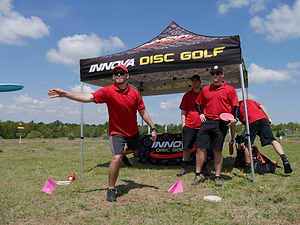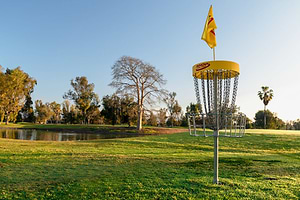Disc Golf Guide: The Science of Flight
TOC
Table of Contents
There is a lot of science behind disc golf physics. Factors like velocity, throwing angle, drag, lift and spin will have different effects on flying discs. The discs themselves have different design traits that allow them to fly in various flight paths.
Today, we want to talk about the science of flight when it comes to disc golf. We will pull some references directly from one of our favorite disc golf book, “The Definitive Guide to Disc Golf” by Justin Menickelli, Ph.D, and Ryan “Slim” Pickens, M.A. If you have not read this book yet, pick up a copy in the DGU Store. It covers everything you need to know about the basics—and a few not-so-basics—of disc golf.
We’ve covered the history of disc golf, the anatomy of disc golf discs, flight numbers, Innova plastic types and other reference topics on the DGU Blog, but we really haven’t dove into the physics of flight. Let’s break down some of the science you might want to know. Understanding what makes a disc fly can actually help you become a better thrower.
Force, Vectors and Moments
A force is any influence that causes an object to start, stop, speed up, slow down, or change direction. A force has both magnitude and direction, making it a vector quantity… Torque (also called rotary force) is the turning effect produced by force. The moment of a force is the measure of its tendency to cause an object to rotate about a specific point or axis.
Ultimately, there are different forces imparted by a player when he or she throws a disc golf disc. These include velocity, spin and angle. These combine with outside forces such as gravity, drag and/or lift (affected by wind and air density). In addition, you have aerodynamic design forces within different discs that affect acceleration, form drag and surface drag. We’ll provide brief definitions of some of these key terms below:
- Gravity—A constant vertical force defined as the weight of the object. In other words, a disc that goes up must eventually come down.
- Drag—Acts in opposition to the relative motion of an object.
- Lift—Acts perpendicular to the relative motion of an object.
- Acceleration—The rate of change in velocity
Velocity
Most people use the terms velocity and speed interchangeably, but they are mechanically different. Speed is simply the rate of motion. Velocity indicates both magnitude and orientation (direction) and is represented by a vector… As a disc flies, both the magnitude and orientation are constantly changing. After all, as a disc slows down it also rises and falls.
This all affects the relative velocity of the disc during flight, which will bring us to talk about both aerodynamic (the motion of air) and gyrodynamic (the effect of spin) properties.
Science actually shows us that the same disc thrown with the same release velocity, angle and spin will fly differently into a headwind as it does a tailwind. Despite what common sense might make you think, a disc can actually fly farther in a slight headwind. This is because the positive effect of greater lift typically outweighs the effect of additional drag forces.
Of course, the flight also depends on the disc itself. We all know that stable, faster discs are better in headwinds while understable, slower discs are usually best in tailwinds.
Aerodynamic Forces
The two main aerodynamic forces that act on a flying disc are drag and lift. In essence, flying discs behave much like an airplane wing does. As a disc flies, air molecules exert pressure on it. This pressure, called the dynamic fluid force, is proportional to the air density, the surface area of the disc, and the square of the relative velocity of the disc to the air. So, if the relative velocity doubles, the dynamic fluid force roughly quadruples.
Drag forces ultimately decrease relative velocity as the disc flies through the air. As it loses speed, it decelerates and gravity pulls it toward the ground. Which way it turns is largely dictated by the stability of the disc itself. The gyroscopic spin of an overstable disc like a Firebird or Destroyer will ultimately force it to go left at the end of a right-hand backhand throw. A more understable disc like a Mamba may want to hold straighter or fall to the right, though it also depends on the release angle and velocity imparted by the player.
A disc golfer with a slow arm speed and hyzer release angle will likely still see their understable disc end up going left at the end of the flight. However, they may get more flight out of the understable disc compared to an overstable disc that will dump left as soon as it leaves their hand. This is why more advanced disc golfers with good release velocity, spin and angle control can utilize different discs to achieve different flight paths.
Drag forces are produced by two different means:
- Form Drag—Also known as profile or shape drag, form drag is the sum of the impact forces resulting from the collision between the air molecules and a flying disc. It is most influenced by the design properties of a disc.
- Surface Drag—Also known as viscous drag, surface drag is the sum of the friction of forces acting between the air molecules and the surface of a disc. It is also impacted by the friction forces between the air molecules themselves. This is why a roughed up “seasoned” disc will fly differently than when it was new. All those scratches, scuffs, dents and dings will provide more friction and increase surface drag.
Angles
Pitch angle (also called the angle of attack) is a disc’s back-to-front tilt relative to its direction of flight. Pitch angle is an important variable because it is dictated by the thrower (initially) and because it significantly affects drag, lift, and other forces. The optimal pitch angle depends on the style of throw and type of disc, but nearly flat is a good reference point.
A disc golfer releases the disc on a specific back-to-front pitch angle, as well as a specific side-to-side angle. Both will have different effects. A nose-up release will want to release while nose down will push faster to the ground. A hyzer throw for a RHBH player will want to go left while an anhyzer will want to turn right (at least for the first half of the throw). Here are some other terms to know when talking about angles and gyroscopic properties of discs:
- Center of Mass (COM)—Located in the center of most disc golf discs, regardless of rim width.
- Center of Pressure (COP)—The center of pressure is where drag and lift have the most effect.

The COP is not in the same place on every golf disc. Putters and approach discs have a low rim-to-flight plate mass ratio. Their outer circumference is weighted more than the center, though the overall mass is distributed fairly equally throughout the entire disc. These discs tend to have a COP close to the COM.
On the other hand, wide-rimmed distance drivers have higher rim-to-flight plate mass ratio. Thus, they have a COP farther from the COM. This difference is one factor that allows them to fly farther when thrown with proper velocity and angle.
Gyroscopic Stability
Spin (also called rotation) has little influence on aerodynamics (drag and lift forces), but it does significantly impact a disc’s flight characteristics. A disc thrown with little spin tends to wobble or flutter during flight, while a disc throw with considerable spin will exhibit a more stable, predictable flight pattern.
The spin rate relative to the velocity is called the advance ratio. When you see turn and fade numbers on a disc, the advance ratio is essentially what they represent. How much does the disc want to pull right and/or left when thrown perfectly flat at the ideal velocity?
Choosing the Best Disc
Understanding the science of flight and what the flight numbers mean can help you quite a bit when choosing the best disc golf discs for your game. As you get better, you’ll be able to impart more velocity and spin, and you’ll have more control over your angles. Then, it’s a matter of matching the right discs with the right throws for every type of shot you’ll need on the disc golf course.
We’ve only scratched the surface of the physics in this article. We encourage you to read the book (click here to purchase) for the full breakdown and even more helpful disc golf information.
Personalized Disc Recommendations
Just answer a few questions and we’ll send you personalized recommendations within 24 hours.
GET PRO TIPS

